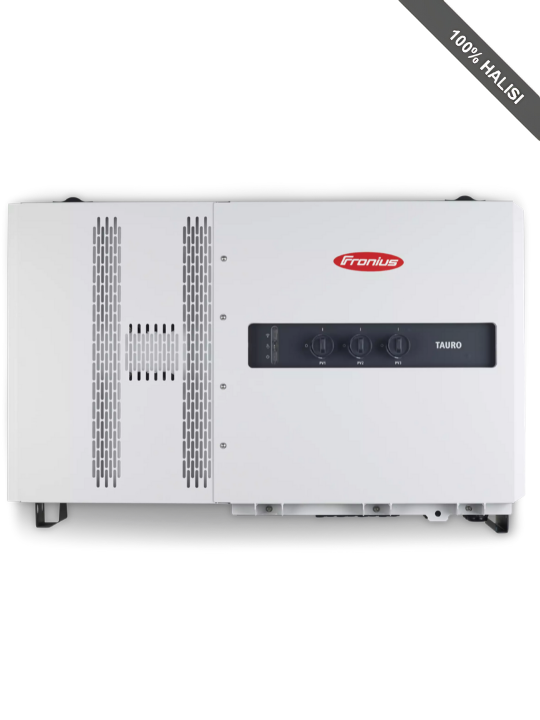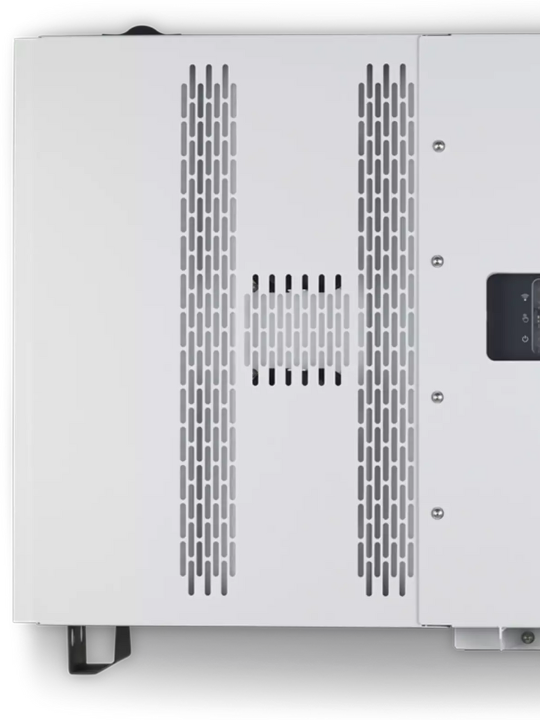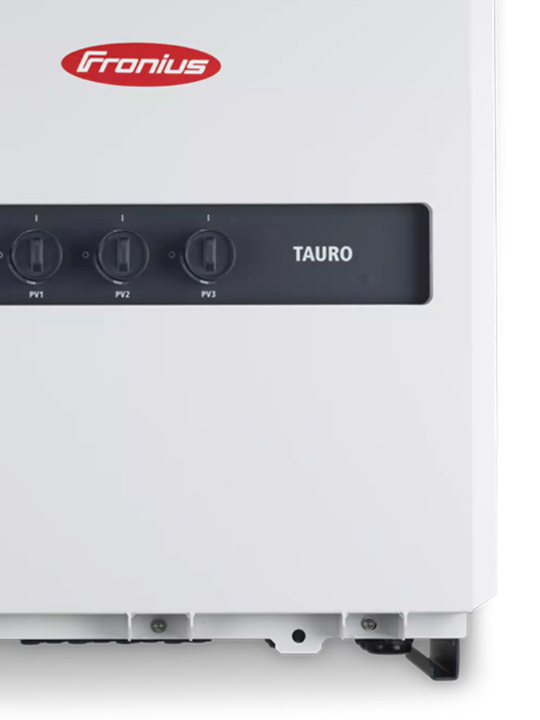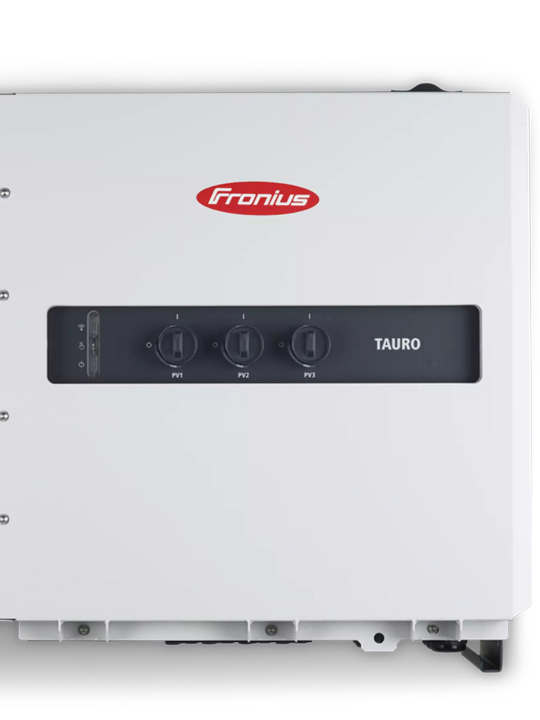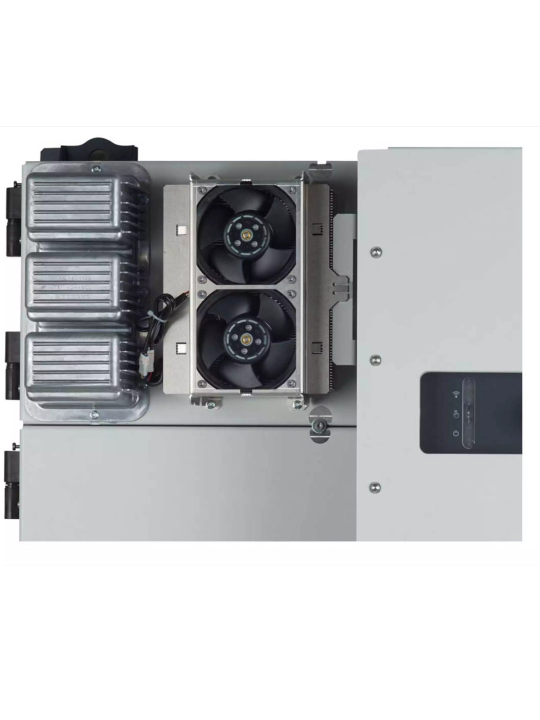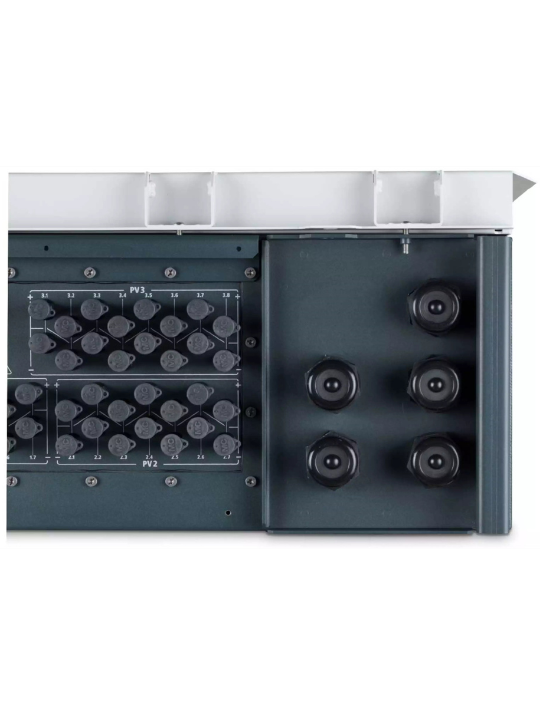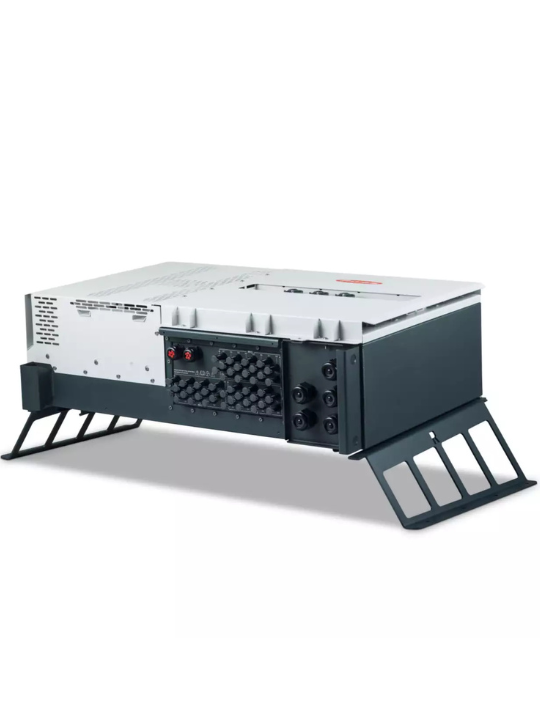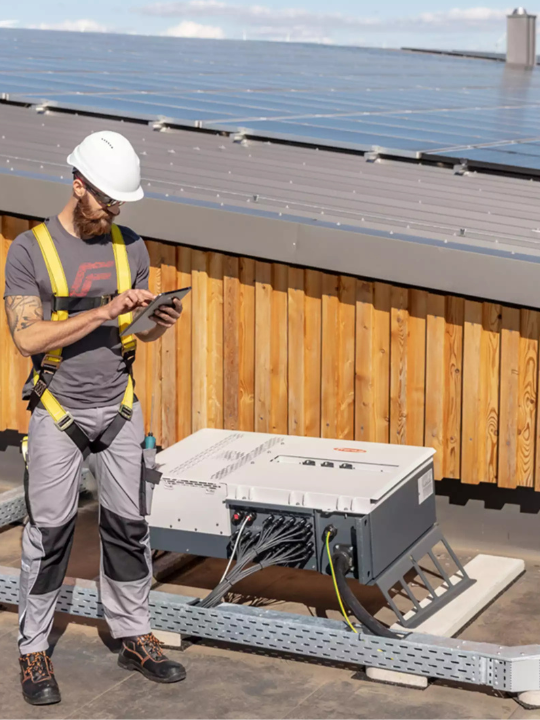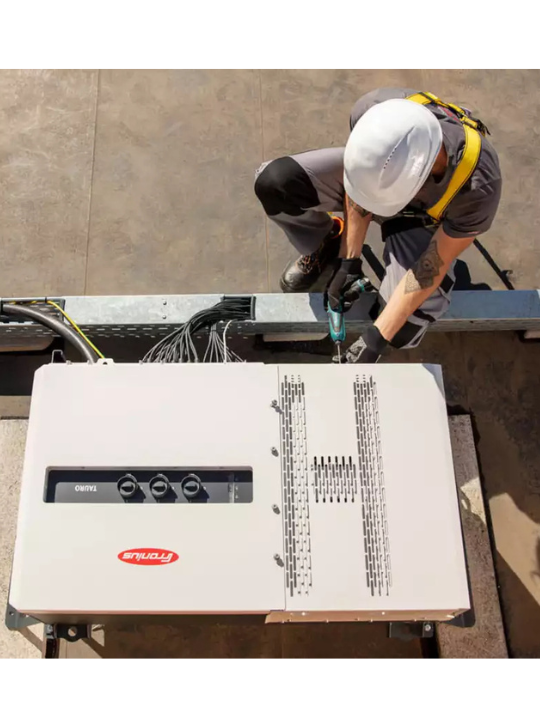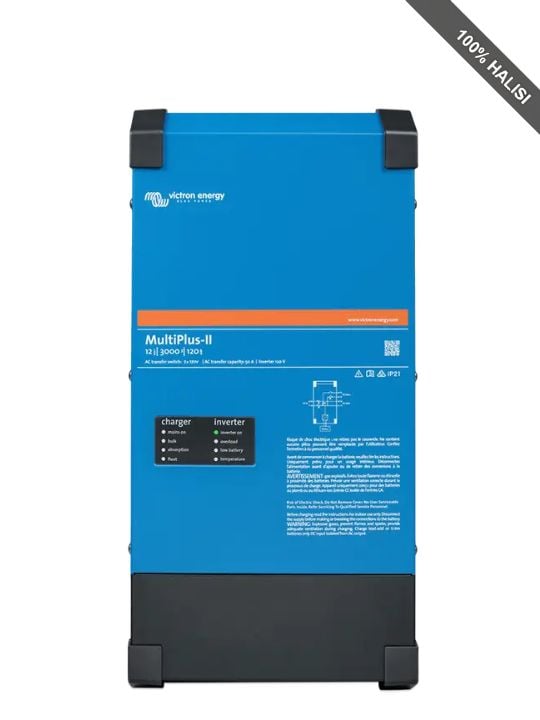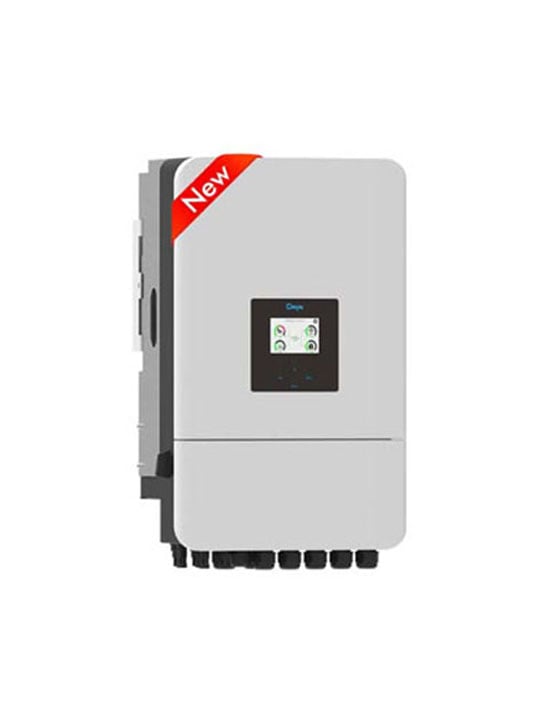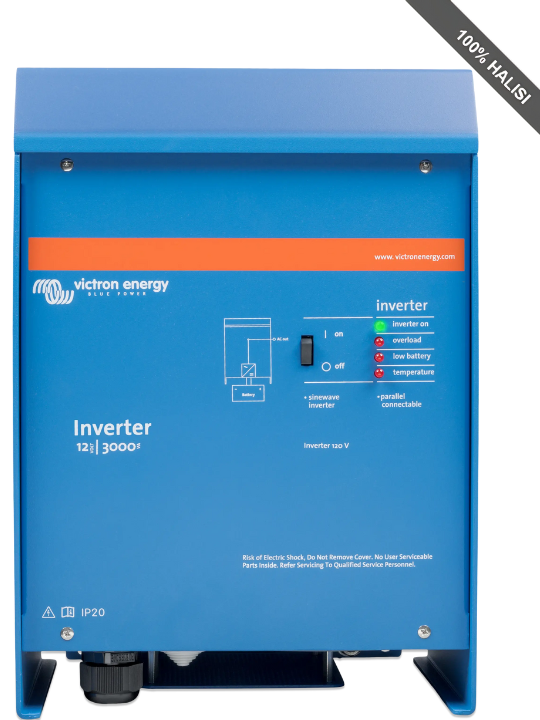The Fronius Tauro 50-3-P is a high-power, industrial-grade, three-phase grid‐tie (PV) inverter in the 50 kW class, engineered for high performance even under tough environmental / electrical conditions. It’s made for installations that need robust, reliable conversion from solar PV DC to AC for feeding into the grid (or large private networks). The design emphasizes flexibility in system layout, strong efficiency across a wide DC input voltage range, active cooling, good protection features, and ease of service.
Feature & Benefits
From those specs and features, here are key benefits:
- High Efficiency & Low Losses: With ~98.5% peak efficiency, the inverter wastes very little energy in conversion; over large installations, this gives significant savings.
- Wide Operating Voltage & Multiple MPP Trackers: Allows designers to configure PV arrays flexibly (different orientations, shading, tilt), optimizing yield.
- Robustness in Harsh Environments: IP65 rating, wide temp. range, high altitude capability mean this inverter can survive in outdoor, hot, humid, dusty, or high-altitude conditions.
- Reduced BOS (Balance of System) Costs: The flexibility in input voltage, number of trackers, etc., helps lower wiring lengths, reduces need for combiner boxes or lots of junction points.
- Ease of Installation & Maintenance: Features like disconnector, modular DC/AC connections, monitoring interfaces help installers operate faster; service access manageable; remote monitoring reduces need for site visits.
- Safety & Compliance: Meets many international and grid-connection standards, built-in protections; which helps in approvals, insurance, and safer operation.
Use Cases
Possible scenarios / applications where this inverter is very well suited:
- Solar farms or large rooftop PV for commercial / industrial users (factories, warehouses, malls) in Tanzania.
- Off‐grid or mini‐grid-hybrid setups (if there’s grid-tie or feed-in possibilities) or for large communal PV plants feeding local distribution networks.
- Locations with high ambient temperatures, dusty environments, or high altitudes (e.g. highland areas) due to its robust environmental limits.
- Systems where shading or multiple orientations are involved, needing multiple MPPTs for maximum power extraction.
- Situations where remote monitoring and reliable uptime are critical (e.g. paying customers, revenue‐grade installations)
Value Propositions (Why pick this over alternatives)
- Longevity & Reliability: Fewer replacements, backups for failure; lower lifetime cost.
- Flexibility reduces design constraints and lets you scale or adapt.
- High performance ensures better return on investment, quicker payback.
- Lower maintenance & downtime thanks to good protections, cooling & remote monitoring.
- Brand trust & compliance helps in getting approvals, financing.
Local Market Positioning
Considering Tanzania’s solar market, the regulatory, environmental, and economic context, here is how the Fronius Tauro 50-3-P could be positioned, and what challenges / advantages would be relevant.
| Factor |
Implications / Opportunities |
Challenges |
| Solar resource / climate |
Many Tanzanian regions have strong sun, hot weather, sometimes high ambient temps and dust—devices with high temp tolerance, IP65, good cooling are preferred. The Tauro’s specs suit these. |
Cooling and maintenance under dusty/humid conditions are still burdensome; need periodic cleaning, possibly de-rating under extreme conditions. |
| Grid availability & stability |
For customers connected to the grid (industries, large users) wanting to reduce energy bills, feed surplus back etc., this inverter can serve well. Tanzania is expanding its grid, and regulations for net‐metering / feed-in are evolving. |
Grid instability (voltage fluctuations, frequency issues) may stress inverters; local standards & certifications must be met; possible issues with harmonics, reactive power compensation. |
| Cost sensitivity |
While premium, the long-term savings in efficiency, durability, lower maintenance could make the higher upfront cost justified, especially for customers with large scale installs. |
The initial capital cost is significant. Local financing, import duties, taxes, logistics will affect total cost. Competing lower‐cost inverters might undercut, though at expense of lifespan, efficiency. |
| After-sales & service infrastructure |
Fronius being a known brand may have support / distribution; local service and spares availability would be a strong selling point. Remote monitoring can reduce need for local service. |
If spare parts, trained technicians, support are not locally available or are expensive, downtime or repair delays may hurt customer satisfaction. Also warranty support depends on local agents/distributors. |
| Regulatory / standards compliance |
Because the Tauro is certified to many IEC, EN standards, it is well placed for regulatory approval for grid‐tie projects; helps with investor confidence and bankability. |
Tanzania may have local or regional standards or grid codes that differ; ensuring compatibility (voltage, frequency tolerances, safety certifications) is necessary. Also import tariffs, taxes can make overall cost higher. |
Technical Specification
| AC Output (Grid Side) |
|
| Nominal AC Output Power |
50 kW |
| Maximum AC Apparent Power |
50 kVA |
| AC Nominal Voltage |
3~ NPE 380/220 V or 400/230 V |
| AC Voltage Range |
180 – 270 V |
| Nominal AC Frequency |
50 / 60 Hz |
| Maximum Output Current |
75.8 A (220 V) / 72.5 A (230 V) |
| Power Factor |
0–1 adjustable (inductive/capacitive) |
| Total Harmonic Distortion (THD) |
<3% |
| DC Input (PV Side) |
|
| Maximum PV Generator Power |
75 kWp |
| Maximum DC Input Voltage |
1000 V |
| DC Voltage Range |
200 – 1000 V |
| MPP Voltage Range |
400 – 870 V |
| Feed-in Start Voltage |
200 V |
| Number of MPP Trackers |
3 |
| Maximum DC Input Current |
134 A |
| Maximum Input Current per PV Input |
PV1: 36 A, PV2: 36 A, PV3: 72 A |
| Maximum Short-Circuit Current per PV Input |
PV1: 45 A, PV2: 45 A, PV3: 90 A |
| Efficiency |
|
| Maximum Efficiency |
98.5% |
| European Efficiency |
~97.7 – 98.5% |
| Environmental Data |
|
| Operating Ambient Temperature |
–40 °C to +65 °C (with AC disconnect: –30 °C to +65 °C) |
| Relative Humidity |
0 – 100% |
| Maximum Operating Altitude |
4000 m |
| Degree of Protection |
IP65 (outdoor rated) |
| Cooling Concept |
Active cooling with double-wall system |
| Mechanical Data |
|
| Dimensions (L × W × D) |
1109 × 755 × 346 mm |
| Weight (without packaging) |
92 kg |
| Weight (with packaging) |
111 kg |
| Installation |
Outdoor / wall-mounted |
| Safety & Protection |
|
| Grid Monitoring |
Yes (integrated) |
| DC Disconnector |
Integrated |
| Residual Current Monitoring |
Integrated (RCMU) |
| Overvoltage Protection |
Type 1+2 built-in (optional Type 2) |
| Standards & Certification |
IEC 62109-1/-2, IEC 61727, CE compliance |
| Interfaces & Communication |
|
| Ethernet (LAN) |
RJ45 (10/100 Mbit) |
| Protocols Supported |
Modbus TCP, Modbus RTU (RS485), Sunspec, JSON via Solar API |
| Datalogger & Webserver |
Integrated |
| Digital I/O |
Yes (for control/load management) |
| Remote Monitoring |
Supported (Fronius Solar.web) |
| Emergency Stop |
Integrated |

